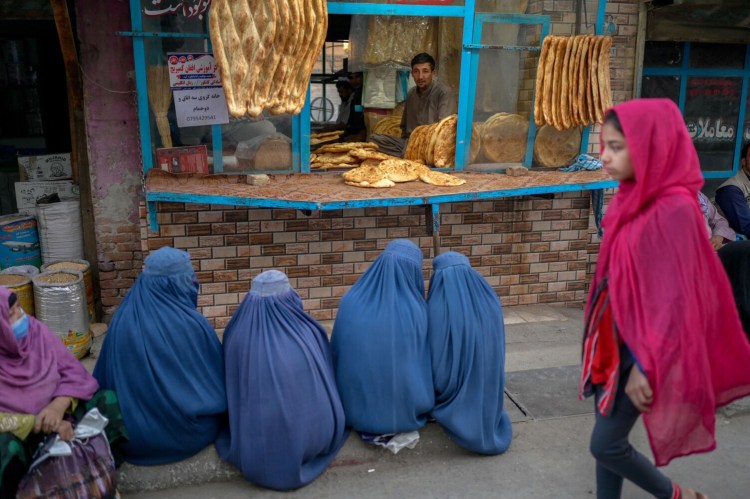One of the Taliban’s first acts after they swept to power in Afghanistan a month ago was to force most working women out of their jobs and into their homes. That’s going to add to the risk of starvation facing the country after years of crop failures and the collapse of this year’s wheat harvest.
In an aid-dependent economy already in deep trouble, the sudden removal of tens of thousands of wage earners, many supporting large, extended families, only adds to the numbers facing hunger in a country where 47.3 percent live below the poverty line. What happens outside the cities could be even more devastating. Women make up nearly a third of the rural labor force. Without them, the problems of a country that’s barely able to feed itself will only be compounded.
EXISTING PROBLEMS GROW WORSE
Afghan women’s No. 1 fear is not being able to work, and losing access to education is a close second, says Heather Barr, associate director of women’s rights at Human Rights Watch. With so many men killed in the conflict, or fleeing the country, a significant number of women have been left as both single parents and sole breadwinners supporting their parents and other relatives.
“The Taliban cutting off women’s ability to work is not about their feelings of empowerment – though this is important – it is about losing any ability to feed themselves and their family,” Barr notes.
As the Afghanistan Analysts Network, an independent research group, wrote Sept. 6, the price of essential items, from flour to cooking oil, has risen while the value of the afghani, the currency, is depreciating. In a secondhand market in Kabul, desperate families are selling household goods to buy food.
Even before this year’s crisis, Afghanistan was stalked by hunger because of a devastating drought in 2018 and 2019. Only North Korea and six nations in sub-Saharan Africa were making do with fewer daily calories, according to the United Nations’ Food and Agriculture Organization.
The Taliban’s takeover will make all these problems more acute, because poverty, undernourishment and gender inequality go hand in hand. Although women and girls tend to be more resilient in the face of malnutrition, in patriarchal societies they also suffer the worst deprivation and long-term side effects, as more food is allocated to the males of the household.
HUNGER CAUSE, EFFECT OF LOW STATUS
Living on the edge of hunger can be both a cause and effect of women’s reduced status. Economic empowerment typically begins with control over at least some part of the household finances. Even in patriarchal societies, there’s evidence that relinquishing men’s grip over money can lead to a virtuous circle of increasing equality, earnings and well-being. The effects can be significant: Malnutrition among children falls about 43 percent when women are in control of any rise in incomes, and the improvement is even greater when they have better access to education.
For that advancement to happen, though, there must first be surplus income. With the Taliban removing women’s ability to earn money and food prices surging, the chances of that are diminishing fast. About 53 percent of household spending in rural Afghan households goes to food alone, according to one 2014 study, and likely hasn’t gotten better in the last seven years. With expenditure largely going to raw commodities such as wheat flour or rice, it’s also much more exposed to movements in the market.
U.S. futures prices for wheat, the mainstay of the Afghan diet, last month hit their highest level in eight years. Thanks to the long-term effects of that drought and coronavirus, wheat flour prices in Kabul have been about 20 percent above historical averages for most of the past year. That’s only likely to get worse as a result of the current turmoil: If you think supply chain problems in rich countries are leading to shortages and inflation, it’s nothing next to the sort of civil chaos and uncertainty that’s descended on Afghanistan.
Add to that a banking sector in crisis, with long queues of citizens waiting for what little cash is left in the country. The U.S. and international bodies including the World Bank and the International Monetary Fund have blocked foreign reserves and stopped their regular money transfers.
AID MUST REACH WOMEN
A United Nations conference in Geneva on Monday pledged more than $1 billion in emergency aid. But the question for donors is how to provide assistance quickly, before another harsh winter approaches, without inadvertently funding the Taliban’s vicious crackdown on women, the media, religious minorities and other key parts of civil society.
Behind the scenes, there’s an ugly disagreement playing out among aid organizations including the United Nations, Barr notes. Some agencies are saying if the Taliban won’t allow female relief workers, they should go on and deliver the aid regardless, given the need is so great. Others say having female workers is the only way of ensuring aid reaches women – an assertion proven time and again.
Whatever happens, it needs to happen fast. As much as 97 percent of the population may sink below the poverty line by the middle of next year without an urgent response to the twin political and economic crises, the United Nations Development Programme warned last week. Hunger may prove as devastating to Afghanistan’s women as the Taliban itself.
Send questions/comments to the editors.


